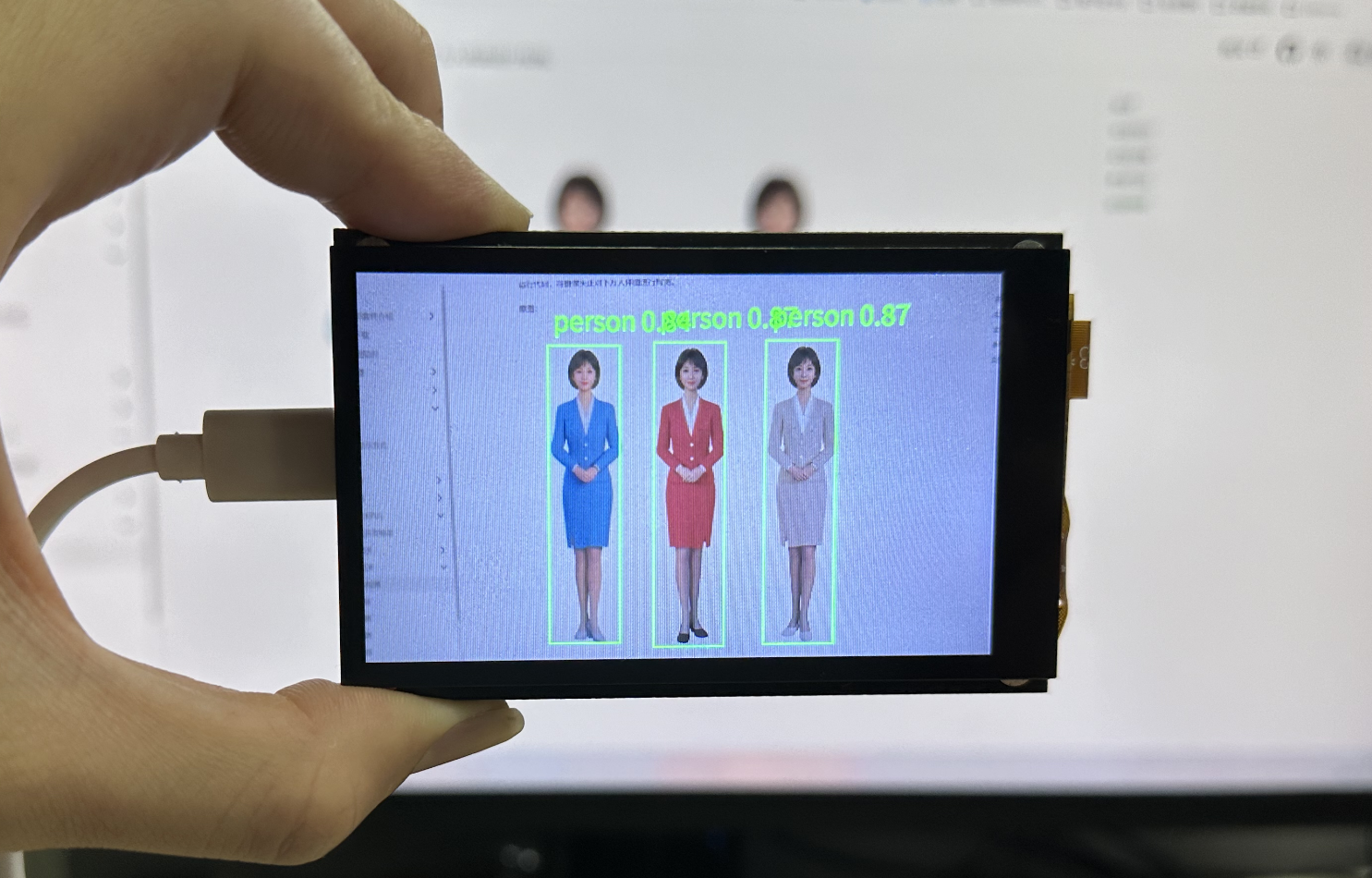人体检测
前言
人体检测是判断摄像头画面中有无出现人体,常用于人体数量检测,人流量监控以及安防监控等。本节我们来学习一下如何通过CanMV AI视觉框架和MicroPython编程快速实现人体检测。
实验目的
将摄像头拍摄到的画面中的人体检测出来并通过画框提示。
实验讲解
本实验通过CanMV K230 AI视觉框架开发,详细说明参考 AI视觉开发框架 章节内容,这里不再重复。例程用到的模型已经存放在CanMV K230的文件系统,无需额外拷贝。
具体编程思路如下:
参考代码
'''
实验名称:人体检测
实验平台:01Studio CanMV K230
教程:wiki.01studio.cc
说明:可以通过display="xxx"参数选择"hdmi"、"lcd3_5"(3.5寸mipi屏)或"lcd2_4"(2.4寸mipi屏)显示方式
'''
from libs.PipeLine import PipeLine, ScopedTiming
from libs.AIBase import AIBase
from libs.AI2D import Ai2d
import os
import ujson
from media.media import *
from media.sensor import *
from time import *
import nncase_runtime as nn
import ulab.numpy as np
import time
import utime
import image
import random
import gc
import sys
import aicube
# 自定义人体检测类
class PersonDetectionApp(AIBase):
def __init__(self,kmodel_path,model_input_size,labels,anchors,confidence_threshold=0.2,nms_threshold=0.5,nms_option=False,strides=[8,16,32],rgb888p_size=[224,224],display_size=[1920,1080],debug_mode=0):
super().__init__(kmodel_path,model_input_size,rgb888p_size,debug_mode)
self.kmodel_path=kmodel_path
# 模型输入分辨率
self.model_input_size=model_input_size
# 标签
self.labels=labels
# 检测anchors设置
self.anchors=anchors
# 特征图降采样倍数
self.strides=strides
# 置信度阈值设置
self.confidence_threshold=confidence_threshold
# nms阈值设置
self.nms_threshold=nms_threshold
self.nms_option=nms_option
# sensor给到AI的图像分辨率
self.rgb888p_size=[ALIGN_UP(rgb888p_size[0],16),rgb888p_size[1]]
# 显示分辨率
self.display_size=[ALIGN_UP(display_size[0],16),display_size[1]]
self.debug_mode=debug_mode
# Ai2d实例,用于实现模型预处理
self.ai2d=Ai2d(debug_mode)
# 设置Ai2d的输入输出格式和类型
self.ai2d.set_ai2d_dtype(nn.ai2d_format.NCHW_FMT,nn.ai2d_format.NCHW_FMT,np.uint8, np.uint8)
# 配置预处理操作,这里使用了pad和resize,Ai2d支持crop/shift/pad/resize/affine,具体代码请打开/sdcard/libs/AI2D.py查看
def config_preprocess(self,input_image_size=None):
with ScopedTiming("set preprocess config",self.debug_mode > 0):
# 初始化ai2d预处理配置,默认为sensor给到AI的尺寸,您可以通过设置input_image_size自行修改输入尺寸
ai2d_input_size=input_image_size if input_image_size else self.rgb888p_size
top,bottom,left,right=self.get_padding_param()
self.ai2d.pad([0,0,0,0,top,bottom,left,right], 0, [0,0,0])
self.ai2d.resize(nn.interp_method.tf_bilinear, nn.interp_mode.half_pixel)
self.ai2d.build([1,3,ai2d_input_size[1],ai2d_input_size[0]],[1,3,self.model_input_size[1],self.model_input_size[0]])
# 自定义当前任务的后处理
def postprocess(self,results):
with ScopedTiming("postprocess",self.debug_mode > 0):
# 这里使用了aicube模型的后处理接口anchorbasedet_post_preocess
dets = aicube.anchorbasedet_post_process(results[0], results[1], results[2], self.model_input_size, self.rgb888p_size, self.strides, len(self.labels), self.confidence_threshold, self.nms_threshold, self.anchors, self.nms_option)
return dets
# 绘制结果
def draw_result(self,pl,dets):
with ScopedTiming("display_draw",self.debug_mode >0):
if dets:
pl.osd_img.clear()
for det_box in dets:
x1, y1, x2, y2 = det_box[2],det_box[3],det_box[4],det_box[5]
w = float(x2 - x1) * self.display_size[0] // self.rgb888p_size[0]
h = float(y2 - y1) * self.display_size[1] // self.rgb888p_size[1]
x1 = int(x1 * self.display_size[0] // self.rgb888p_size[0])
y1 = int(y1 * self.display_size[1] // self.rgb888p_size[1])
x2 = int(x2 * self.display_size[0] // self.rgb888p_size[0])
y2 = int(y2 * self.display_size[1] // self.rgb888p_size[1])
if (h<(0.1*self.display_size[0])):
continue
if (w<(0.25*self.display_size[0]) and ((x1<(0.03*self.display_size[0])) or (x2>(0.97*self.display_size[0])))):
continue
if (w<(0.15*self.display_size[0]) and ((x1<(0.01*self.display_size[0])) or (x2>(0.99*self.display_size[0])))):
continue
pl.osd_img.draw_rectangle(x1 , y1 , int(w) , int(h), color=(255, 0, 255, 0), thickness = 2)
pl.osd_img.draw_string_advanced( x1 , y1-50,32, " " + self.labels[det_box[0]] + " " + str(round(det_box[1],2)), color=(255,0, 255, 0))
else:
pl.osd_img.clear()
# 计算padding参数
def get_padding_param(self):
dst_w = self.model_input_size[0]
dst_h = self.model_input_size[1]
input_width = self.rgb888p_size[0]
input_high = self.rgb888p_size[1]
ratio_w = dst_w / input_width
ratio_h = dst_h / input_high
if ratio_w < ratio_h:
ratio = ratio_w
else:
ratio = ratio_h
new_w = (int)(ratio * input_width)
new_h = (int)(ratio * input_high)
dw = (dst_w - new_w) / 2
dh = (dst_h - new_h) / 2
top = int(round(dh - 0.1))
bottom = int(round(dh + 0.1))
left = int(round(dw - 0.1))
right = int(round(dw - 0.1))
return top, bottom, left, right
if __name__=="__main__":
# 显示模式,可以选择"hdmi"、"lcd3_5"(3.5寸mipi屏)和"lcd2_4"(2.4寸mipi屏)
display="lcd3_5"
if display=="hdmi":
display_mode='hdmi'
display_size=[1920,1080]
rgb888p_size = [1920, 1080]
elif display=="lcd3_5":
display_mode= 'st7701'
display_size=[800,480]
rgb888p_size = [1920, 1080]
elif display=="lcd2_4":
display_mode= 'st7701'
display_size=[640,480]
rgb888p_size = [1280, 960] #2.4寸屏摄像头画面比例为4:3
# 模型路径
kmodel_path="/sdcard/examples/kmodel/person_detect_yolov5n.kmodel"
# 其它参数设置
confidence_threshold = 0.2
nms_threshold = 0.6
labels = ["person"]
anchors = [10, 13, 16, 30, 33, 23, 30, 61, 62, 45, 59, 119, 116, 90, 156, 198, 373, 326]
# 初始化PipeLine
pl=PipeLine(rgb888p_size=rgb888p_size,display_size=display_size,display_mode=display_mode)
pl.create(Sensor(width=rgb888p_size[0], height=rgb888p_size[1])) # 创建PipeLine实例
# 初始化自定义人体检测实例
person_det=PersonDetectionApp(kmodel_path,model_input_size=[640,640],labels=labels,anchors=anchors,confidence_threshold=confidence_threshold,nms_threshold=nms_threshold,nms_option=False,strides=[8,16,32],rgb888p_size=rgb888p_size,display_size=display_size,debug_mode=0)
person_det.config_preprocess()
clock = time.clock()
while True:
clock.tick()
img=pl.get_frame() # 获取当前帧数据
res=person_det.run(img) # 推理当前帧
person_det.draw_result(pl,res) # 绘制结果到PipeLine的osd图像
print(res) # 打印结果
pl.show_image() # 显示当前的绘制结果
gc.collect()
print(clock.fps()) #打印帧率
这里对关键代码进行讲解:
- 设置显示方式:
通过改变
display的参数选择hdmi或lcd(3.5寸mipi显示屏)显示图像。
...
# 显示模式,可以选择"hdmi"、"lcd3_5"(3.5寸mipi屏)和"lcd2_4"(2.4寸mipi屏)
display="lcd3_5"
if display=="hdmi":
display_mode='hdmi'
display_size=[1920,1080]
rgb888p_size = [1920, 1080]
elif display=="lcd3_5":
display_mode= 'st7701'
display_size=[800,480]
rgb888p_size = [1920, 1080]
elif display=="lcd2_4":
display_mode= 'st7701'
display_size=[640,480]
rgb888p_size = [1280, 960] #2.4寸屏摄像头画面比例为4:3
...
- 主函数代码:
可以看到使用默认配置后只使用了4行代码便实现了获取当前帧图像、AI推理、绘制结果、显示结果 的识别流程。
代码中res变量为识别结果,可以通过终端打印或结合其它章节内容实现跟其它MCU串口通讯、网络传输。
...
while True:
clock.tick()
img=pl.get_frame() # 获取当前帧数据
res=person_det.run(img) # 推理当前帧
person_det.draw_result(pl,res) # 绘制结果到PipeLine的osd图像
print(res) # 打印结果
pl.show_image() # 显示当前的绘制结果
gc.collect()
print(clock.fps()) #打印帧率
...
实验结果
运行代码,将摄像头正对下方人体图进行检测。
原图:

识别结果:
